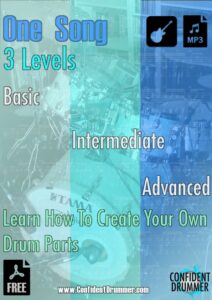In my opinion one of the most exciting aspects of being a drummer is creating drum parts. That’s where being a true musician comes into play. With our grooves and fills we contribute to the song and we can even shape and define the sound and style of a band.
The more personality and charisma a drummer has, the more this is true. Just think of the times when you recognize a tune after the first few drum notes, and realize how powerful a drum part can be.
Creating drum beats is part of the process of writing and arranging a song and here we are going to learn how to use a couple of interesting techniques and ideas.
First of all, not all music needs the drums to be arranged and every beat to be written in detail. The scope of action goes from strict note for note composed parts, to the extreme opposite of just setting an intention about the way it should sound like, depending on the music genre, and then playing freely.
In Jazz it’s rarely required to play specific parts. On the other hand in Pop and Rock and in most modern music we can’t just jam along and hope for our rhythms to sound appropriate.
That’s what we are going to address today. While improvisation is a great tool (check this out if you missed it), and can be a good way to come up with interesting stuff, it’s even more effective (and satisfying) to sit down and try some solutions until we find a pattern that just works perfectly for the song.
Now, since music is art, there’s no absolutely right or wrong way to do anything. These are simply some guidelines to get started in a constructive direction. As soon as we have made some progress we can choose among an infinite number of alternative approaches.
That being said, in order to lay down a good foundation we are going to study this subject using a very simple method, so that we can focus on becoming better at writing drum parts. We will work with a 16 bar song structure, made of an 8 bar verse and an 8 bar chorus. I wrote a simple song, with kind of a Pop vibe, to practice with.
The idea is to listen to it and design a groove for the verse and a different one for the chorus. However, in order to expand our options and apply our creativity, we are going to do this by reasoning in terms of levels and stages. This is a very effective technique, and we are going to begin with the creation of parts that are increasingly more difficult.
We can stick to the standard approach of ‘Basic – Intermediate – Advanced’ levels and experiment with this framework.
That’s the one I have developed in this YouTube video demo: I played a 16 bar verse-chorus form, one time through for each of those levels. You can get the full transcription of what I played here:
Obviously the assignment is not necessarily to study the 3 levels as I played them (but go ahead if you like them), but to write your own versions. Try inventing different grooves and fills for each level and see what you come up with.
Use the drumless audio files linked in the Pdf so that you can play along and experiment with your ideas.
If possible record yourself. It’s amazing to realize how the song changes a lot by just modifying the drum part. I’ve included a GarageBand session which you can use to tape your performance and even change the tempo of the song if you want, so that you can test even more options.
As an additional step, things get a lot more interesting (and also challenging) if we apply different approaches to the way we create and think about levels.
The following are a few frameworks and variations to practice with:
1- Level of difficulty, simple to complex, sparse to busy (the one we just did).
2- Level of density, depth and width. We can choose to focus on different elements of a beat to arrange it in very original ways. Check out this article to learn more.
3- Level of parameters involved. In these case we focus specifically on depth and the features we decide to tweak and make use of in our beats and fills. Things like orchestrations, dynamics, subdivisions, time feel and so on.
4- Level of creativity, from plain and conventional to more unusual, personal and extreme.
Of course after you’ve had some fun working on these ideas with the 16 bars I gave you, the objective is to do the same with the music you play, with your band and so on.
This is a subject that requires a long term commitment, practicing, listening and transcribing lots of music, recording ourselves all the time, and just spending time on these concepts until we start noticing that we effortlessly come up with solutions that make the song better, no matter what the situation.
Related resources:
‘Interpretation & Arrangement’ – Altitude Drumming – Volume 9
‘Art & Musicianship’ – Altitude Drumming – Volume 10




















